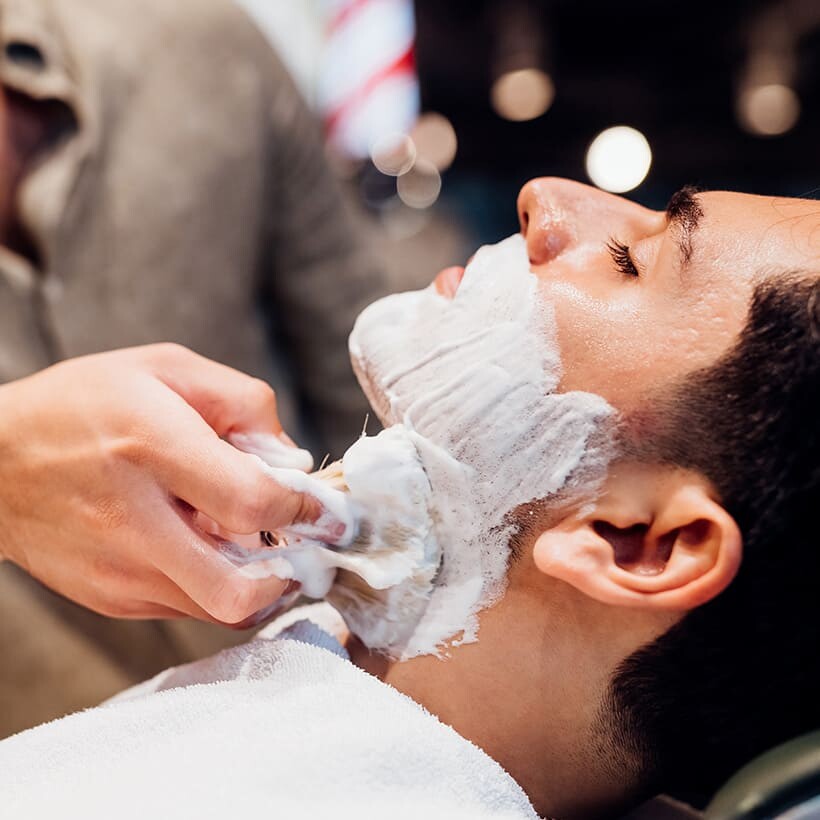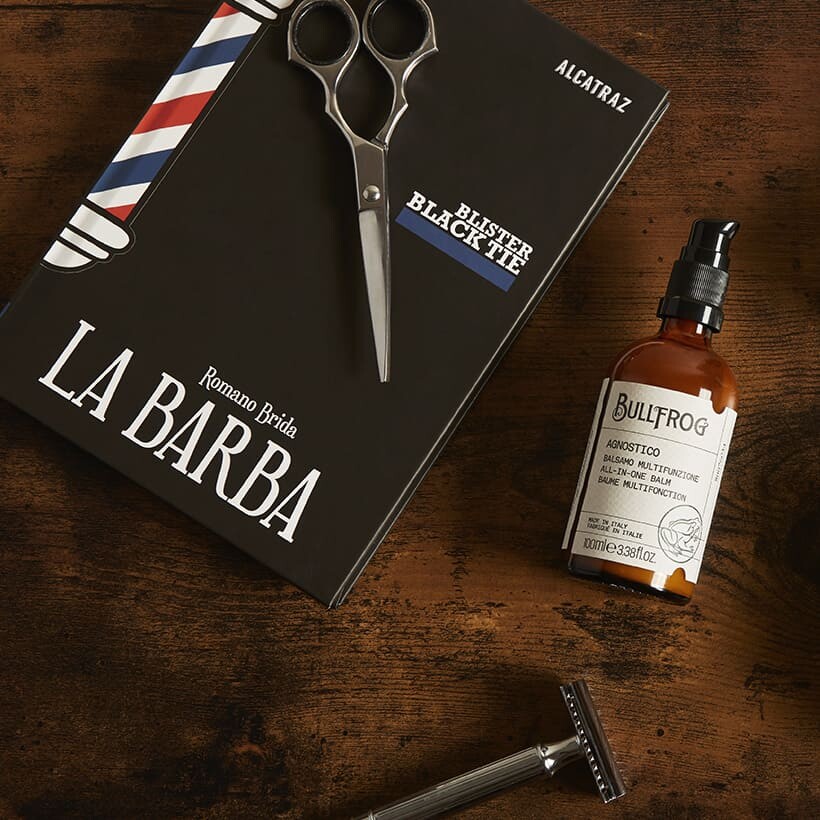Bullfrog: A leap from New York to Portanuova
Today we met Romano Brida, founder and CEO of Bullfrog, a 100% Made in Italy barbershop brand that combines the US razor cut with the Catania comb-and-scissor cut, with an eye on the Anglo-Saxon evolution of styles. About 20 shops in Italy and abroad, with new openings planned worldwide and a single flagship store, inaugurated last summer at Portanuova. A both pleasant and educational conversation on traditions and historic events, including boiled frogs, bloodletting, tenacious skins, and hot rags, Boardwalk Empire and Peaky Blinder, beatniks, hippies, hipsters, and even Alessandro Manzoni, by a barber in the flesh who has never cut a beard or given a haircut in his life.
PN: Why the bullfrog?
RB: It is not an Instagram-friendly animal, but is full of “stories”. In North American culture, it’s the frog species that – when kissed by a princess – does not go back to being a prince, but mischievously turns the unfortunate princess into another frog. The hippie community believes that when you lick it (or kiss it), it has psychedelic effects. More in general, it is a truly politically incorrect frog: it doesn’t croak, but rather moos, it is aggressive (it bites), and feeds on rodents and birds, not little mosquitos like any old toad.

PN: Talk about yourself and what led you to start the business.
RB: Let me say this clearly: I am not a barber. Before Bullfrog, I was an IT consultant for a Japanese multinational. When choosing a name for the barbershop I decided to open when I left my previous job, I thought back on a story I used to tell the companies that I helped reorganize to explain the concept of adaptation to new market demands. This is the reason behind the name: the story of the boiling frog (the following tale is not for the weak-stomached – Author’s note). A frog immersed in boiling water will quickly hop out of the pot, but if the water is cold and heated slowly, the animal won’t notice the difference, it will relax (it is a cold-blooded animal that loves the heat), and will not stand a chance of surviving once the water boils. A truculent story, but one that exemplifies how a myriad of companies and employees adapt submissively to changes as if they were anaesthetized, incapable of taking initiative or reacting to strive. Well, in 2012, I was the boiling frog. With a last-gasp effort, I hopped to the US for a sabbatical, and found out how much the frog was a recurring theme in the rock and biker culture, two worlds I love and belong to. And to exaggerate, I didn’t choose just any frog, but the bullfrog!
PN: You said you imported the world of star-spangled barbershops of the Italian-American neighbourhoods that we know from Coppola’s and Scorsese’s movies, but contaminated it with a pinch of “Italianness”. How did you do this?
RB: In 2011, still recovering from the aforementioned burns, I was in New York for the year off I gave myself to understand what I wanted to be when I grew up. As I monkeyed around in Brooklyn, I was struck by the barbershops; so traditional, yet managed by modern young men, with tattoos and a passion for music, cars, motorbikes, and skateboarding. I immediately thought that this new format combining the past and present didn’t exist in Italy. I spoke about it with my friend Russell, which you can see at work in his shop Ludlow Blunt even in Boardwalk Empire. I told him how the traditional figure of the barber in our country had vanished with the rise of the beat generation and long hair, which paved the way for a new generation of unisex hairdressers that relegated the old barbers (those who “worked during mass”, i.e. even on Sunday mornings) to be a subcategory. The final blows to the ancient art were AIDS in the 1980s and the boom of electric razors. Then, there was a trend inversion thanks to a forgotten culture of the American 1940s, which regained popularity in our country in the first decade of the 2000s: the hipster culture. On with the beards, the fades, and the marked outlines. I had to ride that wave. I returned to Milan ready for action, but to my surprise, I couldn’t find barbers in line with the format I had in mind – traditional, but up-to-date. So I opened the first Bullfrog with US barbers, and you could only speak English at the shop. Our tradition of comb-and-scissor cut has much more behind it than the US school, but I feel halfway between the old and new world. Thus, when I opened my first shop in 2012, it was an innovative lab combining the razor and scissors.
PN: Did it go well?
RB: It was 3 of us, an American pseudo-inmate with a tattooed face, an errand boy, and me, asking as many as 35 euros for a shave; 20 euros more than D&G’s exclusive Sicilian barbershop. To this day, I say that if it’s practicality you’re looking for, you can avail yourself of the magical single-use products for less than 1 euro. Then why go to the barbershop? That’s when the Catania style comes into play: warm rag, stretched blade strokes, shaving against the growth to be more macho, and even time, which was already money in that scrap of a business plan, because the store, products, and staff all have a cost. To be in line with the other barbers’ pricelists, I should kick you off the chair after 8 minutes. Also consider that our skin is no longer tamugna (tenacious, in Bolognaise dialect) like that of our great-grandparents who worked at workshops or in the fields. We are more delicate, and if I gave you an 8-minute shave, you wouldn’t live an experience, but torture. If, instead, you give me the right time, I can follow the traditional Chicago method: untarnished and relaxed skin, perfect shave, 1 hour of rest like at the beautician. Our time management revolves around giving value to every minute. We follow a procedure that earned us an ISO 9001 certification, perhaps as the only barbershop in the world to have one.

PN: Why are barbershops growingly stylish and refined?
RB: Because they must relight, welcome, and cuddle the memories of when we held our fathers’ hands when they went to get a haircut: it’s like rediscovering your origins. In my mind, the scissors strike personal chords related to family memories that help me reconnect with the past. Lots of Indian and Sri Lankan barbers massage the client’s face, head, and shoulders at the end of the cut. It is becoming common practice in our nation as well, which confirms how grooming is growingly integrated with services normally restricted to the wellness sector and helps overcome the concept of the barbershop as a business strictly focused on the haircut. This is why the new Bullfrog at Portanuova has a grooming lounge: an area for manicure, pedicure, and face care that shifts the focus on aesthetics, with specific rules and timing, just like when you’re on the barber chair.
PN: Is there an exclusive “Bullfrog” cut on your list?
RB: There is the Bullfrog shave. As far as the haircuts go, we rediscovered existing styles and simply created modern evolutions, such as the Caesar cut with short, horizontally-cut bangs, just like Tiberius Caesar Augustus. The Executive Contour, on the other hand, is a traditional US cut with a well-visible side line.
PN: What else makes you stand out?
RB: First of all, I must say Northern Africans are exceptional, and they’re the ones who mirror our service the most. We were the first to open 7 days a week. So much that the old barbers accused us of stealing sons from their families! As for shaving, nobody can beat Egyptians and Turks; in fact, we are about to open 2 shops in Oman.
PN: What are the countries with the greatest barbershop tradition?
RB: Let us begin with the weakest: Eastern Europe and Russia. Arabic countries are the best for beards. South Americans are also talented. A Brazilian who works at the shop at Portanuova even brought back a small manual vibrator to massage the neck and magically loosen its muscles. Even Baja California buts up a challenge: many Latinos still wear hair nets at night to keep their haircut intact.

PN: A note of colour (and a historic fun fact): tell us about the origin of the spinning red-and-blue barber pole.
RB: In small towns, barbershops were emergency rooms: barbers were dentists, and even performed bloodletting with a tank full of leeches or a system of cannulas. To signal their presence to often illiterate users, they wrapped a rag drenched in blood to a pole.
PN: Let us move on from the red of the original barber’s job to the green of our day. On your website, you make a plea concerning the use and abuse of plastic packaging. 8 billion plastic bottles per year in Italy alone. What does Bullfrog do to fight this bad habit?
RB: I agreed with Emanuele, who is with us since 2014, to exclude secondary packaging from our products to reduce costs, but above all to help the environment. What do you say, Emanuele?
Emanuele Giannini (Marketing Manager @BF): All of our products are the result of choices, from composition to packaging. We only use post-consumer recycled plastic whenever we cannot use glass – for instance, for a 500-ml (17.6 fl. oz) shampoo that would weigh over 2 kg (4.4 lbs.). As well as normally recycled material, we also use infinitely recyclable material such as glass (for small formats) and aluminium, an element that – at least in Europe – has been reused for the past 50 years: this is why we like to say that the hair pomade you hold in your hand may well have been an airplane before.
PN: Do you believe your customers share your choices and values?
RB: Yes, and so do our employees and franchisees, who are often former clients who fell in love with our project and values. Our best seller is provocatively called Agnostico because, paradoxically, it keeps its promises.
PN: Do you take part in Movember, the cool initiative first launched in Australia, which invites men to grow moustaches throughout November as a fundraiser for prostate cancer research?
RB: As a former rugby player, I’ve always loved Movember, which is why we’ve taken part in it for years. Then, in 2017, we partnered with Caritas Ambrosiana to cut the hair of the homeless – on the day of Saint Ambrose (the patron saint of Milan) – in Via Settembrini by the Central Station. We chose not to promote the event, though a photographer beautifully reported it for a magazine, showing the faces and hands of the barbers alone to protect the privacy and dignity of our “clients”. In the Anglo-Saxon world, barbers do this once every week, without bragging about it.
PN: 8 years ago you opened the first Bullfrog. Why did you choose Portanuova?
RB: It was in Via Thaon de Revel, in the Isola district. We opened our first flagship store at PN – in Piazza Alvar Aalto – this summer. Bullfrog comes in different versions: small, medium, and integrating retail. We needed a place to combine all our styles, thus the traditional barbershop with three chairs, a common room to stimulate socialization, and a grooming lounge. Portanuova is perfect, it has it all: a nice park, services, the underground station, parking lots, and a spine-tingling skyline.
PN: To celebrate your first 8 years, you chose to be the ones to bring a gift, and not for one person, but the entire community. You will donate 80 trees – 10 for each year – to the city of Milan, through the Forestami project.
RB: Exactly. While at our shops, we develop our brand through specific “Green Choices”: natural ingredients, sustainable packaging – with a reduction of plastic to a bare minimum or use of 100% recyclable plastic, and promotion of eco-friendly consumer habits. Also, since 2020, our Milan stores run on renewable energy. As we stated in an interview to a newspaper: “it is a wish for rebirth: we shall breathe again, after such a tough time”.
PN: Do you hang around Portanuova even off work? Where do you go? What do you like about the district?
RB: Well, we all know and enjoy the restaurants. Moreover, Portanuova is a man-sized and liveable area: you can see a German banker jogging beside Filipinos break-dancing in front of the windows of the Nike Store. That’s what I call being civil. Nobody plants studs in the ground to chase them off… quite the opposite!
PN: One last question: does Bullfrog have the classic barber pole?
RB: Yes, it has the European red-and-white one. As I said, the US version also has the blue stripe to distinguish the arterial blood from the venous blood on the white “rag” (plus the 3 colours also represent the national flag). In Bangkok, instead, two barber poles indicate a brothel.
PN: How many poles do you have in Piazza Alvaar Alto?
RB: Two! (laughs) But only because the store is very big and calls for mordant communication.
For more information, check out the books by Romano Brida:
- On the history of Bullfrog: In barba a tutti, Bullfrog ed.
- On the history of the beard: La barba, Alcatraz ed.